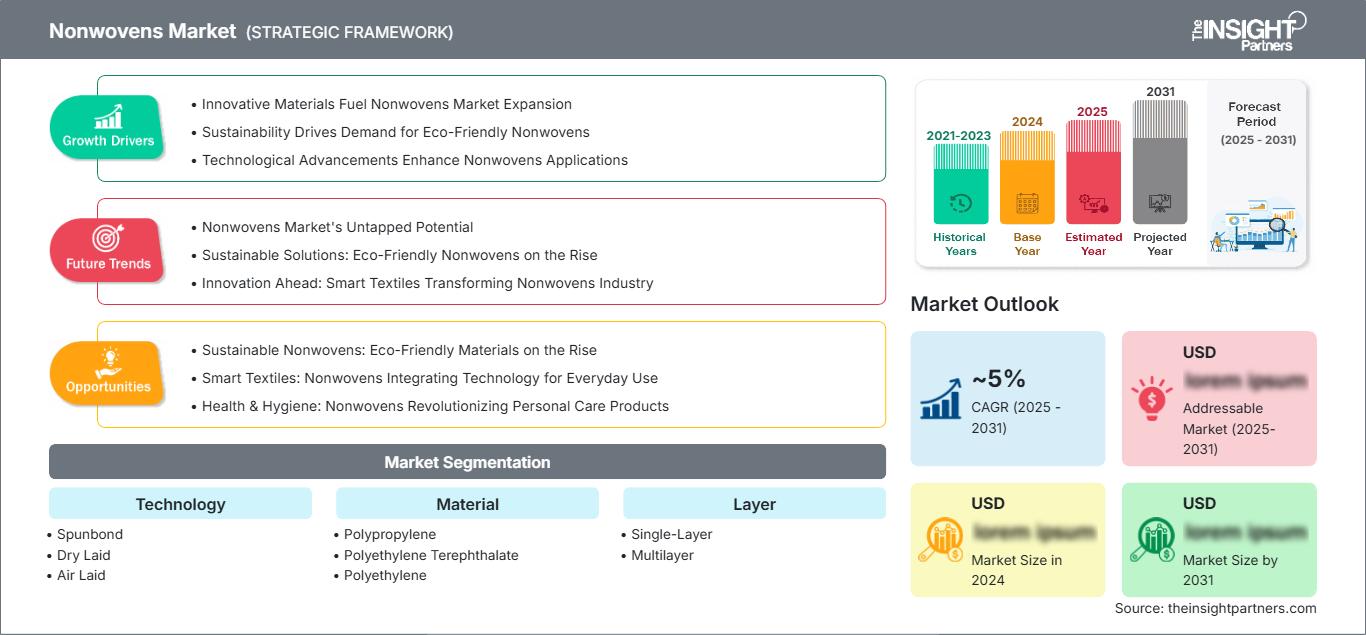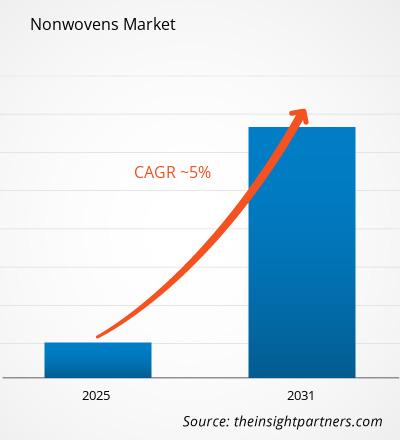من المتوقع أن يسجل سوق الأقمشة غير المنسوجة معدل نمو سنوي مركب بنسبة ~5٪ من عام 2025 إلى عام 2031، مع توسع حجم السوق من XX مليون دولار أمريكي في عام 2024 إلى XX مليون دولار أمريكي بحلول عام 2031.
يُصنّف التقرير حسب التقنية (سبونبوند، دراي لايد، إير لايد، ويت لايد)، ويُحلل السوق بناءً على المواد (بولي بروبيلين، بولي إيثيلين تيريفثالات، بولي إيثيلين، رايون، لب الخشب). كما يُحلل السوق حسب الطبقة (أحادية الطبقة، متعددة الطبقات) ووظيفة الصناعة (للاستخدام مرة واحدة، غير للاستخدام مرة واحدة). ويُقدّم تحليلاً شاملاً على المستويات العالمية والإقليمية والقُطرية لكل من هذه القطاعات الرئيسية.
يتضمن التقرير حجم السوق وتوقعاته لجميع القطاعات، مع عرض القيم بالدولار الأمريكي. كما يُقدّم إحصاءات رئيسية حول الوضع الحالي للسوق لدى أبرز الشركات، بالإضافة إلى رؤى حول اتجاهات السوق السائدة والفرص الناشئة.
غرض التقرير
يهدف تقرير "سوق المواد غير المنسوجة" الصادر عن "ذا إنسايت بارتنرز" إلى وصف المشهد الحالي والنمو المستقبلي، وأهم العوامل المحفزة، والتحديات، والفرص المتاحة. وسيوفر هذا التقرير رؤى ثاقبة لمختلف أصحاب المصلحة في قطاع الأعمال، مثل:
- مزودي/مصنعي التكنولوجيا: لفهم ديناميكيات السوق المتطورة ومعرفة فرص النمو المحتملة، وتمكينهم من اتخاذ قرارات استراتيجية مستنيرة.
- المستثمرون: لإجراء تحليل شامل للاتجاهات فيما يتعلق بمعدل نمو السوق، والتوقعات المالية للسوق، والفرص الموجودة عبر سلسلة القيمة.
- الهيئات التنظيمية: لتنظيم السياسات ومراقبة الأنشطة في السوق بهدف تقليل الانتهاكات والحفاظ على ثقة المستثمرين ودعم سلامة السوق واستقرارها.
تجزئة سوق الأقمشة غير المنسوجة
تكنولوجيا
- سبونبوند
- وضع جاف
- وضع الهواء
- وضع مبلل
مادة
- البولي بروبيلين
- بولي إيثيلين تيريفثالات
- البولي إيثيلين
- رايون
- لب الخشب
طبقة
- طبقة واحدة
- متعدد الطبقات
وظيفة
- يمكن التخلص منه
- غير قابلة للتخلص منها
ستحصل على تخصيص لأي تقرير - مجانًا - بما في ذلك أجزاء من هذا التقرير، أو تحليل على مستوى الدولة، وحزمة بيانات Excel، بالإضافة إلى الاستفادة من العروض والخصومات الرائعة للشركات الناشئة والجامعات
سوق الأقمشة غير المنسوجة: رؤى استراتيجية

-
احصل على أهم اتجاهات السوق الرئيسية من هذا التقرير.ستتضمن هذه العينة المجانية تحليل البيانات، بدءًا من اتجاهات السوق وحتى التقديرات والتوقعات.
عوامل نمو سوق الأقمشة غير المنسوجة
- المواد المبتكرة تُعزز توسع سوق الأقمشة غير المنسوجة
- الاستدامة تدفع الطلب على الأقمشة غير المنسوجة الصديقة للبيئة
- التطورات التكنولوجية تعزز تطبيقات الأقمشة غير المنسوجة
اتجاهات مستقبل سوق الأقمشة غير المنسوجة
- إمكانات سوق المنسوجات غير المنسوجة غير المستغلة
- حلول مستدامة: تزايد استخدام الأقمشة غير المنسوجة الصديقة للبيئة
- الابتكار في المستقبل: المنسوجات الذكية تُحدث تحولاً في صناعة الأقمشة غير المنسوجة
فرص سوق الأقمشة غير المنسوجة
- الأقمشة غير المنسوجة المستدامة: مواد صديقة للبيئة في ازدياد
- المنسوجات الذكية: المنسوجات غير المنسوجة التي تدمج التكنولوجيا للاستخدام اليومي
- الصحة والنظافة: الأقمشة غير المنسوجة تُحدث ثورة في منتجات العناية الشخصية
رؤى إقليمية حول سوق الأقمشة غير المنسوجة
قام محللو شركة "ذا إنسايت بارتنرز" بشرح شامل للاتجاهات الإقليمية والعوامل المؤثرة في سوق المنسوجات غير المنسوجة خلال فترة التوقعات. ويناقش هذا القسم أيضًا قطاعات سوق المنسوجات غير المنسوجة ونطاقها الجغرافي في أمريكا الشمالية، وأوروبا، وآسيا والمحيط الهادئ، والشرق الأوسط وأفريقيا، وأمريكا الجنوبية والوسطى.
نطاق تقرير سوق الأقمشة غير المنسوجة
| سمة التقرير | تفاصيل |
|---|---|
| حجم السوق في عام 2024 | XX مليون دولار أمريكي |
| حجم السوق بحلول عام 2031 | XX مليون دولار أمريكي |
| معدل النمو السنوي المركب العالمي (2025 - 2031) | ~5% |
| البيانات التاريخية | 2021-2023 |
| فترة التنبؤ | 2025-2031 |
| القطاعات المغطاة |
حسب التكنولوجيا
|
| المناطق والبلدان المغطاة |
أمريكا الشمالية
|
| قادة السوق وملفات تعريف الشركات الرئيسية |
|
كثافة اللاعبين في سوق الأقمشة غير المنسوجة: فهم تأثيرها على ديناميكيات الأعمال
يشهد سوق الأقمشة غير المنسوجة نموًا متسارعًا، مدفوعًا بتزايد طلب المستخدمين النهائيين نتيجةً لعوامل مثل تفضيلات المستهلكين المتطورة، والتقدم التكنولوجي، وزيادة الوعي بمزايا المنتج. ومع تزايد الطلب، تعمل الشركات على توسيع عروضها، والابتكار لتلبية احتياجات المستهلكين، والاستفادة من الاتجاهات الناشئة، مما يعزز نمو السوق.

- احصل على نظرة عامة على أهم اللاعبين الرئيسيين في سوق المنسوجات غير المنسوجة
نقاط البيع الرئيسية
- التغطية الشاملة: يغطي التقرير بشكل شامل تحليل المنتجات والخدمات والأنواع والمستخدمين النهائيين لسوق الأقمشة غير المنسوجة، مما يوفر صورة شاملة.
- تحليل الخبراء: تم تجميع التقرير على أساس الفهم العميق لخبراء الصناعة والمحللين.
- المعلومات الحديثة: يضمن التقرير أهمية الأعمال التجارية بسبب تغطيته للمعلومات الحديثة واتجاهات البيانات.
- خيارات التخصيص: يمكن تخصيص هذا التقرير لتلبية متطلبات العملاء المحددة وتلبية استراتيجيات العمل بشكل مناسب.
لذا، يُمكن أن يُساعد تقرير البحث حول سوق المنسوجات غير المنسوجة في تمهيد الطريق لفهم سيناريوهات هذه الصناعة وآفاق نموها. ورغم وجود بعض المخاوف المُبررة، إلا أن فوائد هذا التقرير الإجمالية تفوق عيوبه.
- التحليل التاريخي (سنتان)، سنة الأساس، التوقعات (7 سنوات) مع معدل النمو السنوي المركب
- تحليل PEST و SWOT
- حجم السوق والقيمة / الحجم - عالمي، إقليمي، بلد
- الصناعة والمنافسة
- مجموعة بيانات إكسل
التقارير الحديثة
شهادات العملاء
سبب الشراء
- اتخاذ قرارات مدروسة
- فهم ديناميكيات السوق
- تحليل المنافسة
- رؤى العملاء
- توقعات السوق
- تخفيف المخاطر
- التخطيط الاستراتيجي
- مبررات الاستثمار
- تحديد الأسواق الناشئة
- تحسين استراتيجيات التسويق
- تعزيز الكفاءة التشغيلية
- مواكبة التوجهات التنظيمية






















 احصل على عينة مجانية ل - سوق الأقمشة غير المنسوجة
احصل على عينة مجانية ل - سوق الأقمشة غير المنسوجة